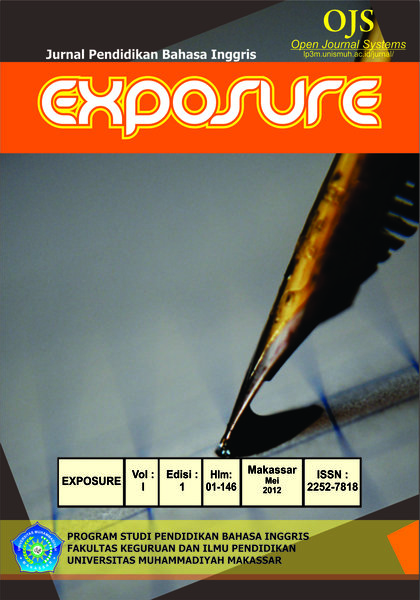THE APPLICATION OF THREE-STEP TO INCREASE THE STUDENTS’ SPEAKING ABILITY
DOI:
https://doi.org/10.26618/exposure.v1i1.768Abstract
This research was intended to explain the students’ speaking accuracy and fluency through Three-Step Interview Method in class XI-2 of SMA Negeri 2 Bantaeng in the 2011/2012 academic year. This research used A Classroom Action Research (CAR). It had conducted in two cycles; each cycle consisted of four meetings. The subjects of this research were students in class XI-2 involved 40 students. Those consisted of 30 women and 10 men. The researcher took real data from the class to know the students’ speaking ability. The instruments of this research were speaking test and observation sheet in cycle I and in cycle II. The research findings indicated that the Three-Step Interview Method improved the students’ speaking ability covered students’ accuracy and fluency in class XI-2 of SMA Negeri 2 Bantaeng. It was indicated that there was an improvement of the students’ speaking ability from the diagnostic test to cycle I and from that to cycle II. The students’ diagnostic test of speaking ability was (5.47) and after gave action by using three-step interview method indicated that there was the improvement from diagnostic test to cycle I and from that to cycle II. The students’ speaking ability in cycle I was 63.00% and in the cycle, II become 76.50% and it was classified as good. While the standard target scores 70% one which was categorized well. From these findings, there was a significant improvement of the students’ speaking ability through Three-Step Interview Method. Based on the result finding the research concludes that Three-Step Interview Method can improve the students’ speaking ability.
Keywords: Application, Three-Step, Increase, Speaking.
References
Badulu, Abdul Muis. 2001. Introduction to linguistics. Makassar: State University of Makassar.
Broughton, Geoffary. I997. Teaching English as Foreign Language. London: Routledge & Kangan Paul London.
Byrne. 1976. Teaching oral English. Singapore: Longman Publisher.
Clark, H. Herber, et al. 1977. Psychology and Language. USA: Harcourt Brace Jovanovich Publisher.
Davidson and worshon, T.1992. enhancing thinking through cooperative learning.Newyork.availableon: http//www.emc.maricopa.edu/innovation/CCL/building.html.
Gay, L., R. 1981. Educational Research, Competencies for Analysis and Application. Chicago: Charles E. Merril Publishing Company.
Harmer, Jeremy. 1991. The Practice of English Language. New York: Longman Publisher.
Johnson, D. W., & Johson H. 1991. Learning together and alone: Cooperation, competition, and individualization(3rd ed.). Engkwood Cliffs, NJ: Prentice-Hall.
Kagan, Spencer. 1994. Cooperative learning. San Clemente, CA: Kagan Publishing.
Longman, 1995. Contemporary English Dictionary. New York: Longman. English Contemporary press.
Layman. 1972. Technique in Testing. New York: Oxford University Press.
Lipton, L., & Wellman, B. (1998). Patterns and practices in the learning-focused classroom. Guilford, Vermont: Pathways Publishing. http://its.guilford.k12.nc.us/act/strategies/three_step_interview.htm
Marcel, 1978. English speaking elements. Last update June, 15th 2010.
Available on http//eng. gsu.Edu/mos.dog/ghtml.
Nunan, David. 1991. Language Teaching Methodology Macquarie. Sidney: University of Sidney.
Ur, Penny. 1996. Course in Language Teaching practiced and Theory. Cambridge: Cambridge University Press.
Widdowson. H.G1978. Teaching Language as Communication. London: Oxford. University Press.
Downloads
Published
Issue
Section
License
Authors who publish with this journal agree to the following terms:
In order to assure the highest standards for published articles, a peer review policy is applied. In pursue of the compliance with academic standards, all parties involved in the publishing process (the authors, the editors and the editorial board and the reviewers) agree to meet the responsibilities stated below in accordance to the Journal publication ethics and malpractice statement.
Duties of Authors:
- The author(s) warrant that the submitted article is an original work, which has not been previously published, and that they have obtained an agreement from any co-author(s) prior to the manuscript’s submission;
- The author(s) should not submit articles describing essentially the same research to more than one journal;
- The authors(s) make certain that the manuscript meets the terms of the Manuscript Submission Guideline regarding appropriate academic citation and that no copyright infringement occurs;
- The authors(s) should inform the editors about any conflict of interests and report any errors they subsequently, discover in their manuscript.
Duties of Editors and the Editorial Board:
- The editors, together with the editorial board, are responsible for deciding upon the publication or rejection of the submitted manuscripts based only on their originality, significance, and relevance to the domains of the journal;
- The editors evaluate the manuscripts compliance with academic criteria, the domains of the journal and the guidelines;
- The editors must at all times respect the confidentiality of any information pertaining to the submitted manuscripts;
- The editors assign the review of each manuscript to two reviewers chosen according to their domains of expertise. The editors must take into account any conflict of interest reported by the authors and the reviewers.
- The editors must ensure that the comments and recommendations of the reviewers are sent to the author(s) in due time and that the manuscripts are returned to the editors, who take the final decision to publish them or not.
Authors are permitted and encouraged to post online a pre-publication manuscript (but not the Publisher’s final formatted PDF version of the Work) in institutional repositories or on their Websites prior to and during the submission process, as it can lead to productive exchanges, as well as earlier and greater citation of published work (see The Effect of Open Access). Any such posting made before acceptance and publication of the Work shall be updated upon publication to include a reference to the Publisher-assigned DOI (Digital Object Identifier) and a link to the online abstract for the final published Work in the Journal.

